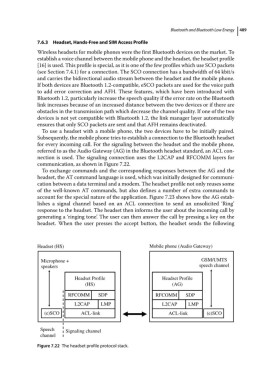Page 503 - From GMS to LTE
P. 503
Bluetooth and Bluetooth Low Energy 489
7.6.3 Headset, Hands‐Free and SIM Access Profile
Wireless headsets for mobile phones were the first Bluetooth devices on the market. To
establish a voice channel between the mobile phone and the headset, the headset profile
[16] is used. This profile is special, as it is one of the few profiles which use SCO packets
(see Section 7.4.1) for a connection. The SCO connection has a bandwidth of 64 kbit/s
and carries the bidirectional audio stream between the headset and the mobile phone.
If both devices are Bluetooth 1.2‐compatible, eSCO packets are used for the voice path
to add error correction and AFH. These features, which have been introduced with
Bluetooth 1.2, particularly increase the speech quality if the error rate on the Bluetooth
link increases because of an increased distance between the two devices or if there are
obstacles in the transmission path which decrease the channel quality. If one of the two
devices is not yet compatible with Bluetooth 1.2, the link manager layer automatically
ensures that only SCO packets are sent and that AFH remains deactivated.
To use a headset with a mobile phone, the two devices have to be initially paired.
Subsequently, the mobile phone tries to establish a connection to the Bluetooth headset
for every incoming call. For the signaling between the headset and the mobile phone,
referred to as the Audio Gateway (AG) in the Bluetooth headset standard, an ACL con-
nection is used. The signaling connection uses the L2CAP and RFCOMM layers for
communication, as shown in Figure 7.22.
To exchange commands and the corresponding responses between the AG and the
headset, the AT command language is used, which was initially designed for communi-
cation between a data terminal and a modem. The headset profile not only reuses some
of the well‐known AT commands, but also defines a number of extra commands to
account for the special nature of the application. Figure 7.23 shows how the AG estab-
lishes a signal channel based on an ACL connection to send an unsolicited ‘Ring’
response to the headset. The headset then informs the user about the incoming call by
generating a ‘ringing tone’. The user can then answer the call by pressing a key on the
headset. When the user presses the accept button, the headset sends the following
Headset (HS) Mobile phone (Audio Gateway)
Microphone + GSM/UMTS
speakers speech channel
Headset Profile Headset Profile
(HS) (AG)
RFCOMM SDP RFCOMM SDP
L2CAP LMP L2CAP LMP
(e)SCO ACL-link ACL-link (e)SCO
Speech Signaling channel
channel
Figure 7.22 The headset profile protocol stack.

